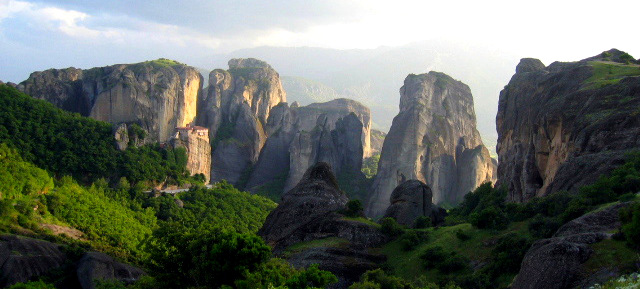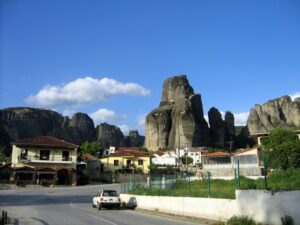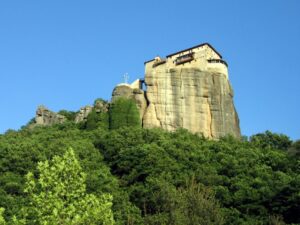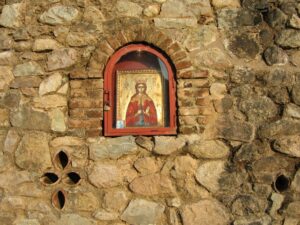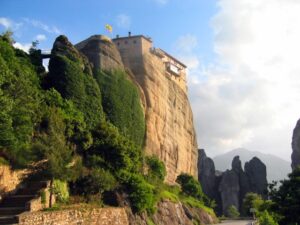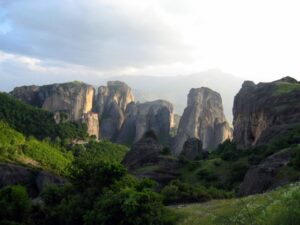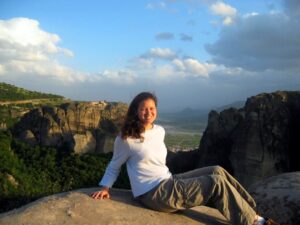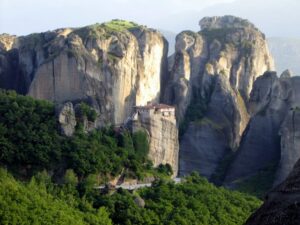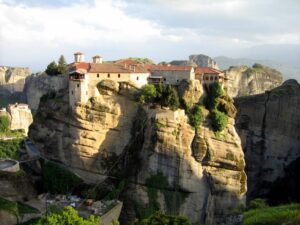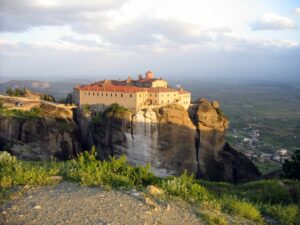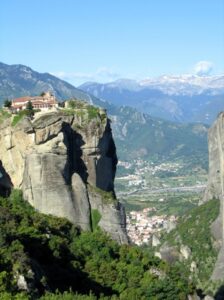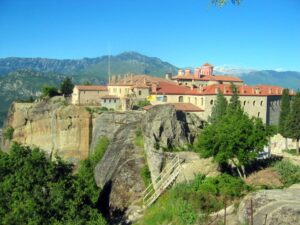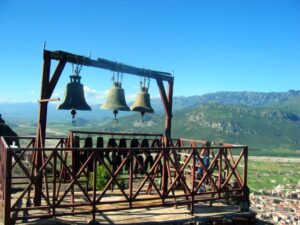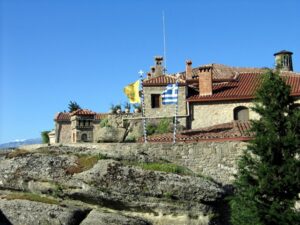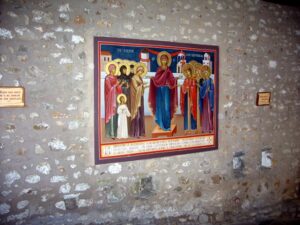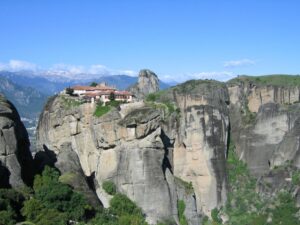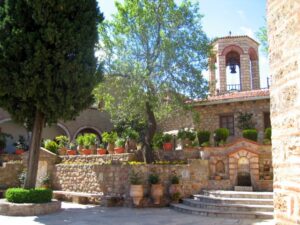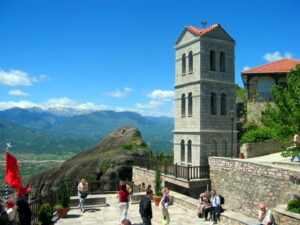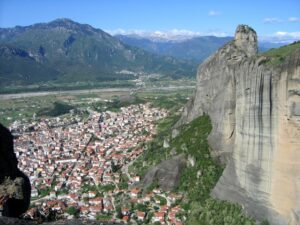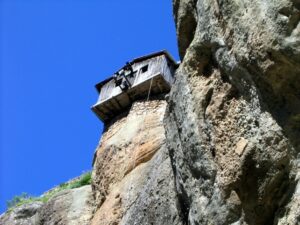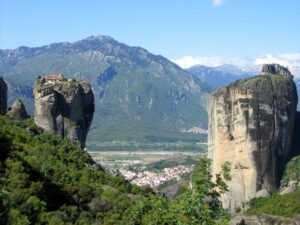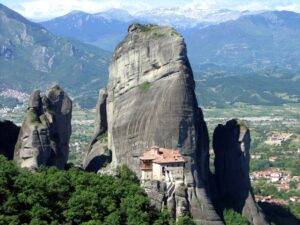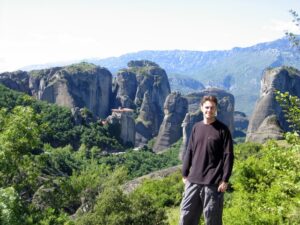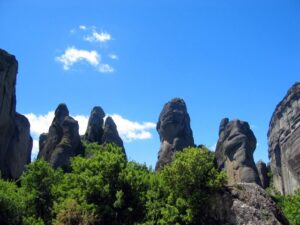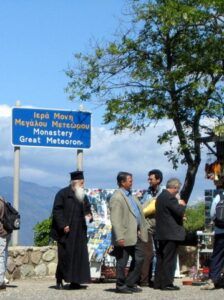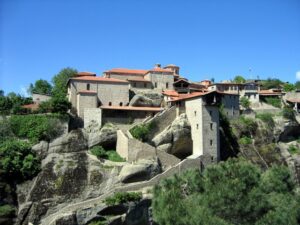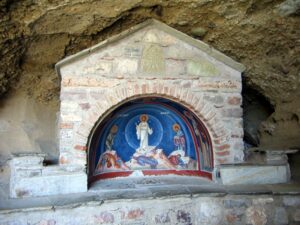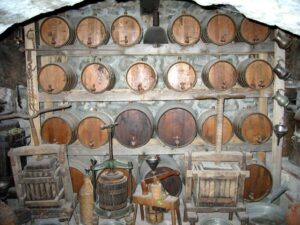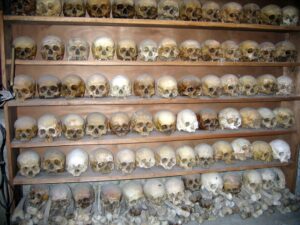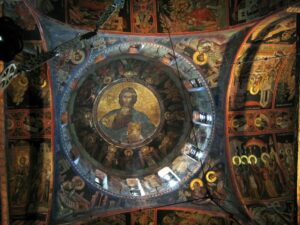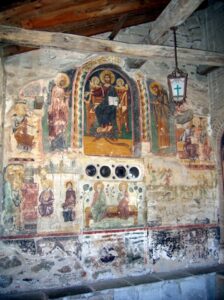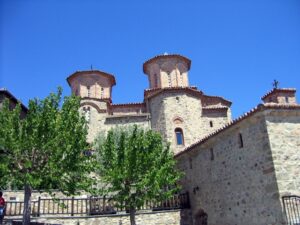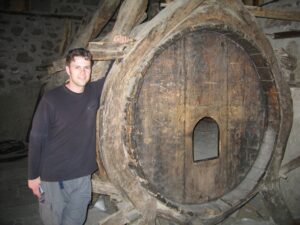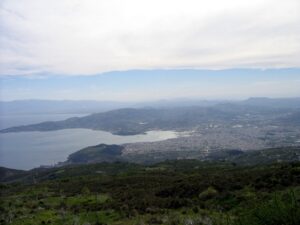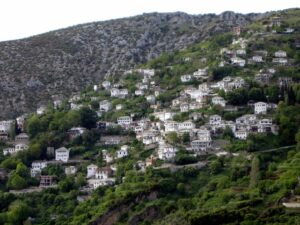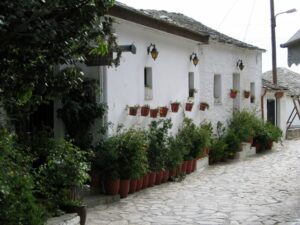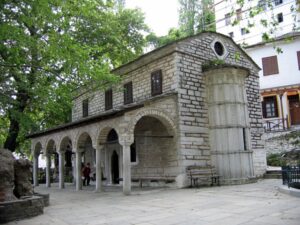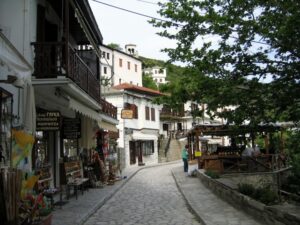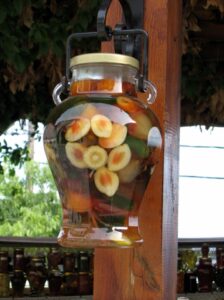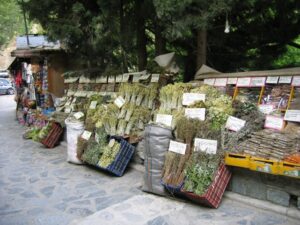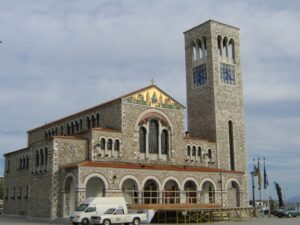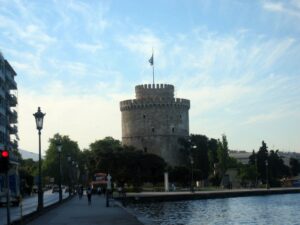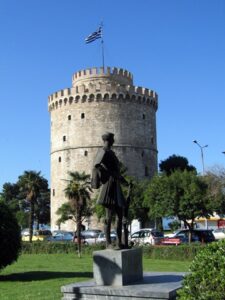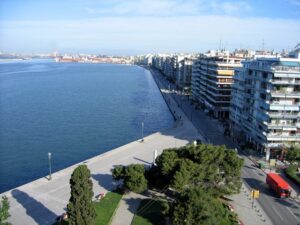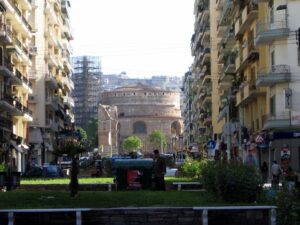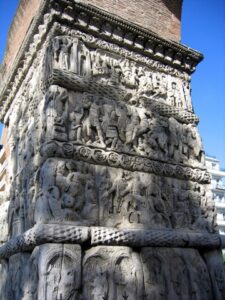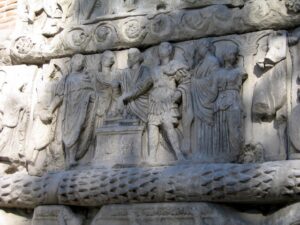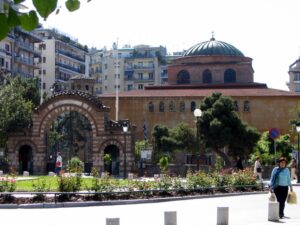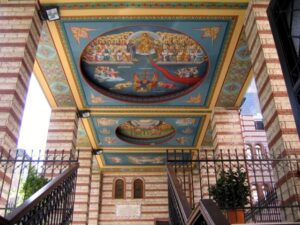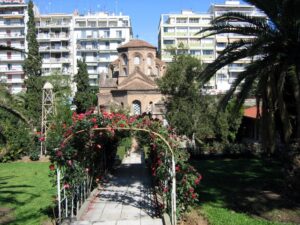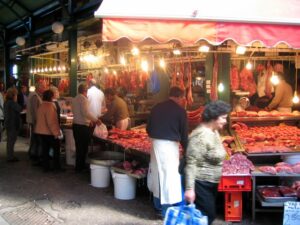After we saw a Germanwings flight linking Stuttgart to Thessaloniki, we decided it was time to visit mainland Greece. The reason? We were keen on checking out Meteora, which had fascinated us for years. What better excuse than a long Memorial day weekend? The weather in late May was fabulous and Meteora lived up to our high expectations. Bonus city was Thessaloniki which we didn’t know much about except it is Greece’s 2nd largest city. Greece remains one of our favorite countries in Europe and we can’t wait to explore more.
In May 2004, we decided to visit Meteora for a quick weekend getaway. This trip was originally planned with one of our friends, John Burns, in mind. In fact, we have decided to dedicate this trip to him, as he was unable to join us. We can just imagine John groaning right now…he’d be claiming that he was the one who had hatched the idea of checking out Meteora and we stole the idea from him! Well, there may be a grain of truth to that, but with or without John, we were determined to see the Meteora for ourselves!
From Stuttgart, we flew on a budget airline, Germanwings (www.germanwings.com) to Thessaloniki (the second largest city in Greece). From there, we rented a car and drove south towards Larissa. Driving in Greece can be maddening, especially since the roads are not well marked at all! In fact, the only way we escaped Thessaloniki (and trust us, we think the locals have a conspiracy to keep all tourists in Thessaloniki, hence the terrible road signs) was by relying heavily on geographical landmarks (sea, mountains) and a map of Greece…thus armed, we were finally able to navigate our way around. The roads in Greece are surprisingly well maintained and we found ourselves zooming along E75. We stopped briefly by a roadside diner and the food was, as expected in Greece, absolutely amazing. We knew we were in for a treat with the fresh salads, freshly grilled meats and succulent (and free flowing) wines. However, first we had to make it to Meteora, so we forced ourselves away from our roadside reverie, and sped off towards Larissa. Once we hit Larissa, it was a westward shot towards Kalambaka, the foreground for the amazing Meteora. The drive there was really pleasant and only took a few hours. Once we hit Kalambaka, we immediately started the 25 km circuit that covered the major monasteries.
A little background on Meteora can be found at this website: (www.kalampaka.com/en/meteora/history.asp)
Meteora appears as a bunch of gnarly black rocks that are vaguely visible on the horizon for miles. The word “meteora” means “in midair” and it has been speculated that they were formed over 30 million years ago, when a seabed suddenly receded, sweeping along all topsoil with it, leaving behind only rock formations.
We were amazed by Meteora. We kept wondering how the first hermits scaled the large rocks, and why they chose such an imposing site as their dwelling. The sun was setting so we had fabulous light to take pictures of the Meteora. As soon as we would turn one corner, another monastery would appear and we rushed from monastery to monastery (sometimes nunnery), trying to catch as many images as possible before we lost daylight. Once the sunset and the last glimpses of rays finally receded, we headed back into Kalambaka to find a place to crash and settled on Hotel Meteora, a budget and conveniently located hotel right at the foothills of Meteora. And it was priced right at 40 euros for two, including breakfast. That night we feasted on lamb and wine…what a lovely way to celebrate one of Greece’s most beautiful sights! We both got a bit tipsy but vowed to wake up early so we could catch Meteora before the busloads of tourists overtook everything. Today we woke up early, ate breakfast and rushed off to our first site, Ayiou Stefanou (St. Stephens), a nunnery. We purposely decided to go in the opposite direction of all the tour buses, which had made a beeline for Meteora’s most popular site, the Great Meteoron. St. Stephens was founded in the 14th century but was badly damaged during World War II and the ensuing civil war that followed it. It was pleasant to visit (although we were lured in with the false sense of ease, as St. Stephens is reached by footbridge and there are few stairs to climb). However, our next stop, the Holy Monastery of Agia Trias, more than made up for our lack of physical exertion at St. Stephens. Agia Trias is famous because of the James Bond movie, For Your Eyes Only, which was filmed here. It is perched high on a cliff and to reach the top, one must endure 140 laboring steps. It wasn’t a bad climb and the view from atop was fantastic. We visited the church, refractor and courtyard and climbed around the cliff tops to admire the view of Kalambaka below. After Agia Trias, we headed towards the Great Meteoron. We had timed the sequence of events perfectly, as the busloads of tourists were now on their way towards Agia Trias, leaving us to explore the Great Meteoron in peace. We could easily see why tour books recommended the Great Meteoron to be the one monastery to see, if tourists had limited time at Meteora. It was absolutely fantastic. The church’s frescoes were amazing, with Christ taking the center of the 12-sided dome, surrounded by the four evangelists, apostles, and prophets below. The wine cellar was pretty neat too, and led us to believe that the monks do more than just pray! After the Great Meteoron, we were on our way to Varlaam, a 16th century monastery that was named after the hermit who lived here and built the chapel in the 14th century. The last stop in Meteora included the tiny Roussanou nunnery, which is fairly accessible thanks to a new bridge. It was the “cutest” of all the sights, with a beautiful courtyard to admire the surrounding views.
We lunched in Kalambaka, and decided to try the lamb and chicken gyros. They were fantastic, although we initially wondered why French fries were being stuffed into the gyros with tzatziki sauce generously poured over everything. However, one bite and we vowed never to eat gyros without fries or tzatziki! They were scrumptious….much better than the donor kebabs we were used to in Germany. After lunch, we drove towards the coastal city of Volos, where we decided to drive up the mountains to the hillside resort town of Makrinitsa. It is a really pleasant whitewashed village that the locals have taken great pains to preserve. The narrow cobblestone streets are full of vendors selling jars of candied fruit, nuts, tea and spices. While driving towards Makrinitsa, the view of the Aegean Sea below was spectacular. However, if we had known what would be in store for us at Thessaloniki, we would have skipped the Volos detour and headed straight there. As it was, Volos was a busy port city and after a few hours spent in the bustling city, we were on our way back to Thessaloniki.
Thessaloniki at night is pure madness. Bumper to bumper insane traffic! It seems that there are far more cars in Thessaloniki than there are inhabitants, and even far fewer parking spaces available. This was evidenced by the double parking that occurred on most streets in the city. We finally stopped and parked (illegally) at an intersection that seemed to be the ripe place for finding lodgings for the evening. Surrounding the square were several hotel options and we struck gold with our first inquiry. Although there was no parking garage available (the receptionist laughed at our inquiry and pointed to the street outside), the room was a bargain at only 60 Euros a night for two (Hotel Esperia, opposite Dioikitiriou Square). We dropped our bags off, took all valuables out of the rental car (fully anticipating our car to be towed away or robbed overnight), and walked down by the waterfront towards the most famous Thessaloniki sight, the White Tower. Little did we know but we were participating in the Thessalonians most popular pastime, the volta, or stroll along the seaside promenade. Hunger overtook us and we found row after row of restaurants near Dikasterion Square. We finally selected one that was serving tasty looking mezze and kicked back with some bottles of house wine.
Our last day in Greece was spent exploring Thessaloniki’s sights. Amazingly, our car was still intact but we decided it would be prudent not to tempt fate so we relocated to a legal parking space and began our tour. We started at the White tower (not really so white anymore). The tower was once used a part of the city’s defense walls, then it was converted into an Ottoman prison (and execution), and today houses the museums of history and art of Thessaloniki. We climbed to the top for a bird’s eye view of the city. After that we headed towards the Palace, of which little remains. We had to use a lot of imagination to picture what it must have looked like in its heyday. To us, it just looked like a bunch of ruins that the city has lovingly cordoned off. The arch of Galerius, built in A.D. 305 is much more impressive. In fact, up until 1953, a tram line used to run right through the archway! However, today the arch stands in the middle of traffic (amazingly, the arch is currently suffering erosion from the elements as it stands unprotected in the middle of a busy street). The details on the arch are still quite vivid, and tells the tale of the Thessalonians victory over the Persians. Our next stop was the Rotunda (Ayios Yioryos), which has massive 20-foot thick walls. The Turks converted the original structure into a mosque (in the 15th century) as evidenced by the sole minaret still standing. The church of Ayia Sofia was next on our agenda. Here we took a moment to admire the ornately carved marble columns supporting the dome. The Greek agora and Roman Forum were next on our wandering tour. Both are undergoing renovations and we decided to pass exploring them for some time in Thessaloniki’s markets: full of fresh seafood and freshly slaughtered meat. It was a noisy and bustling blur of activity and we sought respite from a nearby café. After a couple of hours in Thessaloniki, we were on our way back to the airport for our flight home. Overall it was a really neat trip. We only wished we could have spent a bit more time there, since Greece has a way of growing on you to the point where you don’t want to let go! We are already dreaming about our next Greek adventure….a Greek Islands tour!
